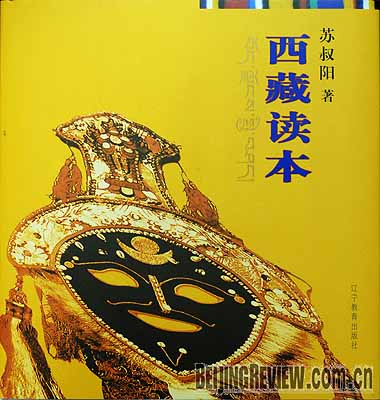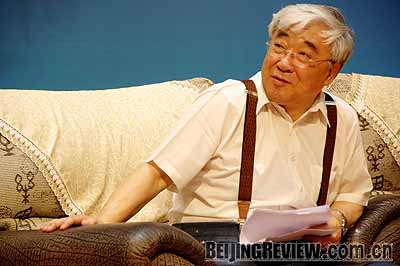By Zan Jifang
Literature on Tibet is usually either political in nature or focuses on Buddhism. It is therefore refreshing to come across a new book on Tibet that focuses more on the history and philosophy of this mysterious land and answers questions on these topics that often puzzle many of us.
|

|
|
A Reader on Tibet provides an easy-to-read look at the history and culture of Tibet [Wei Yao/Beijing Review] |
Chinese writer Su Shuyang's new book, A Reader on Tibet, published in December 2008, is such a book. Made up of seven chapters, the book introduces history, geography, religion, culture, art and other aspects of Tibet, providing informative reading materials for Chinese and foreign readers alike.
It starts with a historic event that took place in 641 when Princess Wencheng (625-680), a niece of Emperor Taizong of the Tang Dynasty (618-907), entered Tibet to marry Songtsan Gambo (617-650), King of the Tubo Kingdom. Tubo was a regime in Tibet during the seventh and ninth centuries. Su pays much attention to the role of Princess Wencheng-Songtsan Gambo marriage in advancing the development of Tibetan culture.
Following the development of Tibet, Su integrates various aspects of the region, including the rise of Buddhism there, the art, and the past and future of Tibet, in order to present a complete picture of Tibet to readers. Based on historical documents, plus vivid descriptions, the book makes interesting reading. Besides, viewing Tibet against the backdrop of the history of the entire world, Su invokes comments and views of foreign scholars about Tibet, making the content objective, authentic and convincing.
"It is not a history book of Tibet, nor records of anecdotes or a thesis on folk customs. It is a probe into some less known aspects of Tibet, particularly for people outside the region," Su said in the book's prologue.
Dedicated writer
Su said that the idea of writing this book originated from suggestions of some friends, Chinese and foreign, at the Frankfurt Book Fair in 2006. "They said that it would be helpful to readers to write a book introducing Tibet, including its past and present, from the historical and academic perspectives," Su said at a seminar in Beijing on December 30, 2008.
Su said that many foreigners he knew do not know the history and culture of Tibet completely and have some misunderstandings of Tibet today. So, he decided to write a book to help those people.
Because of poor health, Su, 71, has never visited Tibet.
"I was diagnosed with cancer three times," Su said. "Though my doctor warned me that I should not go to places higher than 1,500 meters in altitude, I dream of going to Tibet one day."
Su admitted that before writing A Reader on Tibet, his knowledge about Tibet was what he learned in primary school. But after three years of studies, he found that he knew Tibet all over again. "I am confident that everyone who is interested in Tibet will be able to get a new understanding of Tibet through my book," he said at the seminar.
Since the latter half of 2006, Su has read more than 200 kinds of historical books and documents and watched more than 50 documentaries on Tibet. As a result, he came to the following conclusions: Tibet entered into the civilization age in the seventh century, which is closely related with the culture of China's inland; Tibetan people have a close kindred spirit with Han people, and while Tibetan Buddhism is very important, it is not the only part of Tibetan culture.
Su dedicated himself to the writing painstakingly and wholeheartedly. One day in March 2008, he found he had almost lost his eyesight. Despite this, he continued his working on the book. In the 177-page book that has been revised three times, readers can find answers of the writer to many questions.
Critic's approval
Yu Xiaoqun, Deputy General Manager of the Liaoning Publishing Group, the publisher of A Reader on Tibet, said at the seminar that Su is not only a writer but also a scholar. "The book is unique as the writer wrote from the perspective of a scholar and a researcher, different with other introductory books on Tibet," he said.
Yu holds that the book looks at Tibet from an objective perspective. It introduces Tibet from a perspective of the comparison between the West and the East. The writer not only referred to the history of China but also consulted views of Western scholars, a very new angle in understanding Tibet. In addition, it looks at Tibet from a realistic perspective. The writer expounds the unique and multi-cultural feature of Tibet, which is of great significance in enriching Tibet studies.
The literary and academic value of the book has also been recognized among the critics. Xu Bailin, former Director of the Theory Study Office of the China Federation of Literary and Art Circles, said in one of his criticisms on A Reader of Tibet that the book is not simply a textbook, but it is an excellent work that has accurate historical facts, profound thinking and poetic expression.
"All these characters and effects convey the unique personal style of the writer, which is the voice of an individual on the history and social development of the country," Xu said.
The book is also welcomed by readers. A netizen said in a post on youdao.com that after reading A Reader on Tibet, he could share the writer's original views about the history of Tibet and feel the sincerity, honesty and passion of the writer.
A Reader on Tibet has attracted the interest of many foreign publishing houses. According to Yu, the book will be translated into seven languages and published worldwide.
Su Shuyang
 |
|
Su Shuyang [File photo] |
Born in 1938, Su Shuyang is a renowned author and screenwriter in China. Starting his literary career in 1956, Su has so far published more than a dozen influential works, including novels, dramas and collections of essays.
Mainly reflecting the life of ordinary Chinese people, his works, such as novels Homeland and Death of Lao She and drama Song of Loyal Hearts, have moved many Chinese readers, especially in the late 1970s and early 1980s.
As one of his most recognized works, Song of Loyal Hearts features some Chinese intellectuals who dedicate themselves to the research of traditional Chinese medicine. It proved a big success in the late 1970s.
Sunset Street is another important work of Su. The movie based on this screenplay became a huge hit in the early 1980s, because it perfectly depicted changes in Chinese society at that time. After that, Su wrote a number of screenplays and novels about the lives of Beijing residents, as well as Chinese intellectuals. Most of these works bear a strong style of Beijing folk culture. Some of them have been translated into different languages and published worldwide.
He also published a poetry collection titled About Love and produced some popular plays such as The Booming China Roses and Drizzle in Spring.
Su was diagnosed with cancer in 1993, at the peak of his literary career. But disease did not defeat him. In recent years, Su has managed to complete seven full-length works with more than 3 million Chinese characters, among which was the well-known A Reader on China, a book about Chinese history and culture. Published in 1999, the book now has English, German and Russian editions. It has sold more than 10 million copies worldwide.
(Beijing Review February 26, 2009)